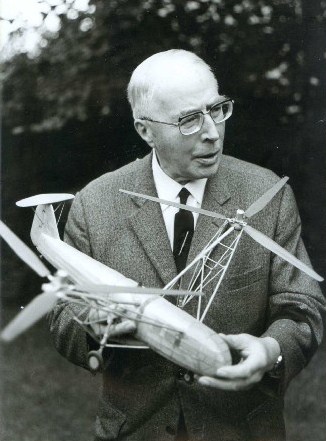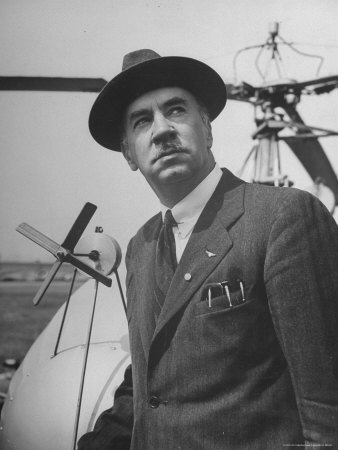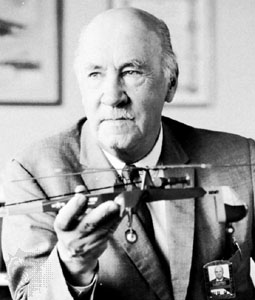<Back to Index>
- Aviation Pioneer Henrich Focke, 1890
- Aviation Pioneer Igor Sikorsky, 1889
PAGE SPONSOR

Henrich Focke (8 October 1890 – 25 February 1979) was a German aviation pioneer from Bremen. He was a co-founder of the Focke - Wulf company.
Born in Bremen on 8 October 1890, Focke studied in Hanover, where he became friends with George Wulf in 1911. In 1914, he and Wulf both reported for military service and Focke was deferred due to heart problems, but was eventually drafted into an infantry regiment. After serving on the Eastern front, he was transferred to the Imperial German Army Air Service.
Focke graduated in 1920 as Dipl-Ing (MS) with distinction. His first
job was with the Francke Company of Bremen as a designer of water - gas
systems. At the same time he continued his aeronautical experimentation,
he and Wulf building the new A VII around the engine from the A VI.
In 1923, with Wulf and Dr. Werner Naumann, Focke co-founded Focke - Wulf - Flugzeugbau GmbH. Wulf died in an accident in 1927 in the F19 "Ente" canard monoplane
In 1930 Focke was offered a chair at the Danzig Institute of Technology, an honor which he declined. In 1931 the city of Bremen awarded him the title of Professor. The same year, Focke - Wulf was merged with the Albatros Flugzeugwerke company.
Focke - Wulf constructed Juan de la Cierva's autogyro under license from 1933, and Focke was inspired by it to design the world's first practical helicopter, the Focke - Wulf Fw 61, which first flew on 26 June 1936.
In 1936 Focke was ousted from the Focke - Wulf company by shareholder pressure. Though the ostensible reason was that he was considered "politically unreliable" by the Nazi regime there is reason to believe it was so that Focke - Wulf's manufacturing capacity could be used to produce Bf 109 aircraft. The company was taken over by AEG, but soon after this the Air Ministry, which had been impressed by the Fw 61 helicopter, suggested that Focke establish a new company dedicated to helicopter development and issued him with a requirement for an improved design capable of carrying a 700 kg (1,500 lb) payload.
Focke established the Focke - Achgelis company on 27 April 1937 in
partnership with pilot Gerd Achgelis, and began development work at
Delmenhorst in 1938.
On 1 September 1945 Focke signed a contract with the French company SNCASE and assisted in development of their SE-3000 passenger helicopter, which was based on the Focke - Achgelis Fa 223 "Drache" and which first flew in 1948.
In 1950, he worked as a designer with the North German Automobile Company (Norddeutsche Fahrzeugwerke) of Wilhelmshaven.
In 1952, Focke and other members of his former design team were employed by Brazil's Centro Técnico Aeroespacial (CTA), at the time the air force's technical center, to develop a Convertiplane, the "Convertiplano", which drew heavily on Focke's wartime work on the Fa 269. Also recruited was Bussmann, a transmission specialist formerly of BMW. The Convertiplano was built using the fuselage and wings of a Supermarine Spitfire Mk 15, which was believed to be one delivered to Argentina as a sales example. Britain refused to supply the Armstrong Siddeley Double Mamba engine originally selected and the design was altered to accept a mid mounted 2200 hp Wright engine instead as used in the Lockheed Constellation, which necessitated a redesign of the transmission due to the increase in weight and vibration. Some 40 workers and US$8 million were devoted to the project, and more than 300 takeoffs were achieved.
While working at the CTA Focke also developed the BF-1 Beija - Flor (hummingbird) two seater light helicopter from 1954, which made its first flight at Sao Jose dos Campos on 22 January 1959. The BF-1 was similar in design to the Cessna CH-1, with a 225 hp Continental E225 engine in the nose and the rotor mast running vertically between the front seats. An open structure tubular steel tail boom carried a pair of tail surfaces and a small tail rotor. The BF-2 was developed from this and first flew on 1 January 1959, and performed an extended flight testing campaign until it was damaged in an accident. It is thought that further work on the Beija Flor was then abandoned.
Focke returned permanently to Germany in 1956 and began developing a three seater helicopter named the "Kolibri" ("hummingbird") at the Borgward company in Bremen, with its first flight taking place in 1958. While working at Borgward Focke set up a wind tunnel in a disused hangar in central Bremen; this wind tunnel was rediscovered in 1997 and is today the centerpiece of a museum devoted to him.
After Borgward collapsed in 1961, Focke became a consulting engineer
with Vereinigte Flugtechnische Werke of Bremen and Deutsche
Forschungsanstalt für Luft - und Raumfahrt. Focke died in Bremen on
25
February 1979.


Igor Sikorsky (May 25, 1889 – October 26, 1972), born Igor Ivanovich Sikorsky was a Russian American pioneer of aviation in both helicopters and fixed wing aircraft. He designed and flew the world's first multi - engine fixed wing aircraft, the Russky Vityaz in 1913, and the first airliner, Ilya Muromets, in 1914.
After emigrating to the United States in 1919, Sikorsky founded the Sikorsky Aircraft Corporation in 1923, and developed the first of Pan American Airways' ocean conquering flying boats in the 1930s.
In 1939 Sikorsky designed and flew the Vought - Sikorsky VS-300, the
first viable American helicopter, which pioneered the rotor
configuration used by most helicopters today. Sikorsky would modify the design into the Sikorsky R-4, which became the world's first mass produced helicopter in 1942.
Igor Sikorsky was born in Kiev, Russian Empire (present day Ukraine), as the youngest of five children. His father, Ivan Alexeevich Sikorsky, had a Russian and noble Polish (Polish: szlachta) family background. A professor of psychology, Ivan was the son and grandson of Russian Orthodox priests and held monarchist and Russian nationalist views.
Igor Sikorsky's mother, Mariya Stefanovna Sikorskaya (née Temryuk - Cherkasova), was a physician who did not work professionally. While homeschooling young Igor, she gave him a great love for art, especially in the life and work of Leonardo da Vinci, and the stories of Jules Verne. In 1900, at age 11, he accompanied his father to Germany and through conversations with his father, became interested in natural sciences. After returning home, Sikorsky began to experiment with model flying machines, and by age 12, he had made a small rubber band powered helicopter.
Sikorsky began studying at the Saint Petersburg
Imperial Russian Naval Academy, in 1903, at the age of 14. In 1906, he
determined that his future lay in engineering, so he resigned from the
Academy, despite his satisfactory standing, and left the Russian Empire
to study in Paris. He returned to Russia in 1907, enrolling at the Mechanical College of the Kiev Polytechnic Institute. After the academic year, Sikorsky again accompanied his father to
Germany in the summer of 1908, where he learned of the accomplishments
of the Wright brothers' Flyer and Ferdinand von Zeppelin's dirigible.
Sikorsky later said about this event: "Within twenty - four hours, I
decided to change my life's work. I would study aviation."
With financial backing from his sister Olga, Sikorsky returned to Paris in 1909 to study aeronautics in the world renowned Ecole des Techniques Aéronautiques et de Construction Automobile (ETACA) engineering school and to purchase aircraft parts. At the time, Paris was the center of the aviation world. Sikorsky would meet with aviation pioneers, to ask them questions about aircraft and flying. In May 1909, he returned to Russia and began designing his first helicopter, which he began testing in July 1909. Despite his progress in solving technical problems of control, Sikorsky realized that the aircraft would never fly. He finally disassembled the aircraft in October 1909, after he determined that he could learn nothing more from the design.
| “ | I had learned enough to recognize that with the existing state of the art, engines, materials, and – most of all – the shortage of money and lack of experience... I would not be able to produce a successful helicopter at that time. | ” |
Sikorsky's first aircraft of his own design, the S-1 used an 15hp Anzani engine, that could not lift the aircraft. His second 25hp Anzani model S-2 flew on 16 June 1910 at a height of a few feet. Later, Sikorsky built the two-seat S-5, his first design not based on other European aircraft. Flying this original aircraft, Sikorsky earned his pilot license; Fédération Aéronautique Internationale (FAI) license No. 64 issued by the Imperial Aero Club of Russia in 1911. During a demonstration of the S-5, the engine quit and Sikorsky was forced to make a crash landing to avoid a wall. It was discovered that a mosquito in the gasoline had been drawn into the carburetor, starving the engine of fuel. The close call convinced Sikorsky of the need for an aircraft that could continue flying if it lost an engine. His next aircraft, the S-6 held three passengers and was selected as the winner of the Moscow aircraft exhibition held by the Russian Army in February 1912.
In early 1912, Igor Sikorsky became Chief Engineer of the aircraft division for the Russian Baltic Railroad Car Works (Russko - Baltiisky Vagonny Zavod or R-BVZ) in Saint Petersburg. His work at R-BVZ included the construction the first four - engine airplane, the S-21 Russky Vityaz, which he called Le Grand. He also served as the test pilot for its first flight on 13 May 1913. In recognition for his accomplishment, he was awarded an honorary degree in engineering from Saint Petersburg Polytechnical Institute in 1914. Sikorsky took the experience from building the Russky Vityaz to develop the S-22 Ilya Muromets airliner. Due to outbreak of World War I, he redesigned it as the world's first four - engined bomber, for which he was decorated with the Order of St. Vladimir.
After World War I, Igor Sikorsky briefly became an engineer for the French forces in Russia, during the Russian Civil War.
Seeing little opportunity for himself as an aircraft designer in war
torn Europe, and particularly Russia, ravaged by the October Revolution
and Civil War, he emigrated to the United States, arriving in New York
on March 30, 1919.
In the United States, Sikorsky first worked as a school teacher and a lecturer, while looking for an opportunity to work in the aviation industry. In 1932, he joined the faculty of the University of Rhode Island to form an Aeronautical Engineering program and remained with the University until 1948. He also lectured at the University of Bridgeport.
In 1923, Sikorsky formed the Sikorsky Manufacturing Company in Roosevelt, New York. He was helped by several former Russian military officers. Among Sikorsky's chief supporters was composer Sergei Rachmaninoff, who introduced himself by writing a check for US$ 5,000 (approximately $61,000 in 2007 dollars). Although his prototype was damaged in its first test flight, Sikorsky persuaded his reluctant backers to invest another $2,500. With the additional funds, he produced the S-29, one of the first twin engine aircraft in America, with a capacity for 14 passengers and a speed of 115 mph. The performance of the S-29, slow compared to military aircraft of 1918, proved to be a "make or break" moment for Sikorsky's funding.
In 1928, Sikorsky became a naturalized citizen of the United States. The Sikorsky Manufacturing Company moved to Stratford, Connecticut, in 1929. It became a part of United Aircraft and Transport (now United Technologies Corporation) in July of that year. The company manufactured flying boats, such as the S-42 "Clipper", used by Pan Am for trans - Atlantic flights.
Meanwhile, Sikorsky also continued his earlier work on vertical flight while living in Trumbull, Connecticut.
On February 14, 1929, he filed an application to patent a "direct lift"
amphibian aircraft which used compressed air to power a direct lift
"propeller" and two smaller propellers for thrust.
On June 27, 1931, Sikorsky filed for a patent for another "direct lift
aircraft", and was awarded patent #1,994,488 on 19 March 1935. His design plans eventually culminated in the first (tethered) flight of the Vought - Sikorsky VS-300
on September 14, 1939, with the first free flight occurring eight
months later on May 24, 1940. Sikorsky's success with the VS-300 led to
the R-4,
which became the world's first mass produced helicopter in 1942.
Sikorsky's final VS-300 rotor configuration, comprising a single main
rotor and a single antitorque tail rotor, has proven to be one of the
most popular helicopter configurations, being used in most helicopters
produced today.
Sikorsky was married to Olga Fyodorovna Simkovitch in Russia. They were divorced and Olga remained in Russia with their daughter as Sikorsky departed ahead of the October Revolution. In 1923, Sikorsky's sisters emigrated to the United States, bringing six year old Tania with them. Sikorsky married Elisabeth Semion (1903 - 1995) in 1924, in New York. Sikorsky and Elisabeth had four sons; Sergei, Nikolai, Igor Jr. and George.
- Tania Sikorsky von York (1918 – 22 September 2008), Sikorsky's eldest child and only daughter. Tania was born in Kiev, Ukrainian People's Republic, eventually part of the Soviet Union. Educated in the United States, she earned a B.A. at Barnard College and a doctorate at Yale. She was one of the original faculty members of Sacred Heart University in Bridgeport, Connecticut, where she served as Professor of Sociology for 20 years.
- Sergei Sikorsky (1925 – ), Sikorsky's eldest son. Sergei served in the United States Coast Guard, and later earned a degree from the University of Florence. He joined United Technologies in 1951, and retired in 1992, as Vice - President of Special Projects at Sikorsky Aircraft.
- Igor Sikorsky Jr. is an attorney, businessman and aviation historian.
- Nickolai Sikorsky
- His grandson, Igor Sikorsky is also a pilot and together with his wife Karen owns and operates Bradford Camps on Munsungun Lake in remote northern Maine.
Sikorsky died at his home in Easton, Connecticut, on October 26, 1972, and was buried in Saint John the Baptist Greek Catholic Cemetery in Stratford. The Sikorsky Memorial Bridge, which carries the Merritt Parkway across the Housatonic River next to the Sikorsky corporate headquarters, is named for him. Sikorsky has been designated a Connecticut Aviation Pioneer by the Connecticut State Legislature. The Sikorsky Aircraft Corporation in Stratford, Connecticut, continues to the present day as one of the world's leading helicopter manufacturers, and a nearby small airport has been named Sikorsky Memorial Airport.
Sikorsky was inducted into the National Inventors Hall of Fame and the Junior Achievement U.S. Business Hall of Fame in 1987.
In October 2011, one of the streets in Kiev was renamed after
Sikorsky. The decision was made by the City Council at the request of
the U.S. Embassy in Ukraine, which opened its new office in that street. The Sikorsky's family house in the city's historical center is preserved to this day but neglected pending restoration.
Sikorsky was a deeply religious Russian Orthodox Christian and authored two religious and philosophical books (The Message of the Lord's Prayer and The Invisible Encounter). Summarizing his beliefs, in the latter he wrote:
| “ | Our concerns sink into insignificance when compared with the eternal value of human personality – a potential child of God which is destined to triumph over lie, pain, and death. No one can take this sublime meaning of life away from us, and this is the one thing that matters. | ” |